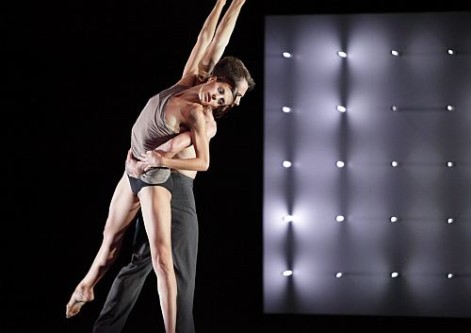 United States Wayne McGregor in collaboration with the dancers, “FAR,” Wayne McGregor Random Dance, Royce Hall UCLA, Los Angeles, 24.01.2014-25.01.2014 (JRo)
United States Wayne McGregor in collaboration with the dancers, “FAR,” Wayne McGregor Random Dance, Royce Hall UCLA, Los Angeles, 24.01.2014-25.01.2014 (JRo)

Photo Credit:
Photo by Ravi Deepres
Animalistic movement – the posturing of monkeys, ostriches, storks, fish – paired with the occasional arabesque, attitude, or jeté of ballet forms the vocabulary of Wayne McGregor’s “FAR.” On Friday evening at UCLA’s Royce Hall his dancers performed this hour-long piece with skill, vigor, and total commitment to the vision of McGregor.
It’s an elaborate vision: McGregor is known for his interest in cognitive science. For “FAR” the program notes explain that the scientific discoveries of the Enlightenment, regarding the newly grasped connection of mind and body inform the piece. Reference to the Enlightenment might be gleaned from the opening: four dancers holding torches appear on stage. Vocal music of Vivaldi plays and a tender duet is performed. But there, any suggestion of Enlightenment concerns ends and we are left without touchstones or focus. The overriding sense is of a sci-fi dystopian future prevails in this essentially numbing hour.
There is much to marvel at: the minimalist purity of a rectangular board of lights by rAndom International– pinpoints on a grid – at times flashing sequentially or spewing numbers across its surface; the stark beauty of Lucy Carter’s lighting design; the seamless transitions of Ben Frost’s score, and the powerful athleticism of the dancers. But ultimately the choreography felt more like a work in progress, random improvisations by individual dancers as fodder for a piece yet to be finished.
On the rare occasions when partners or the corps moved in tandem, it was a welcome relief. Patterns emerged, the stage ignited. There is optimism inherent in a group working together – a sense of community. Dancers moving to their own inner necessity for most of the piece created a sense of isolation and randomness – in and of itself not a problem if it were more judiciously sprinkled throughout the hour.
Many of McGregor’s movements – torqued bodies that convey trauma – have a peculiar beauty all their own; and yet a steady diet of contorted spines and broken limbs made one long for a glimmer of sensuality, a hint of elegance and mystery. I found the occasional extension of an unbroken line a much-needed balm.
Ben Frost’s original music, self-described as structured sound art fused with militant post-classical electronic music contributed to the overall malaise. Mechanistic grindings, sounds of static and electronic vibrations formed the soundtrack, occasionally interspersed with vocal music, but for the most part reinforcing the sameness of the various sections.
We live in an anxious age of joblessness, environmental catastrophe, and an ever-widening gap between rich and poor, where technological advancements rush us headlong into a dubious future. Much of contemporary dance addresses these concerns or is informed by them no matter what the subject matter of the production. The Age of Enlightenment, on the other hand, mixed the excitement of discovery with a sly look at human nature, and gave us the Candide of Voltaire, the Jacques of Diderot. One wished that McGregor had utilized a hint of their humor to lighten his very serious investigations in “FAR.”
Jane Rosenberg